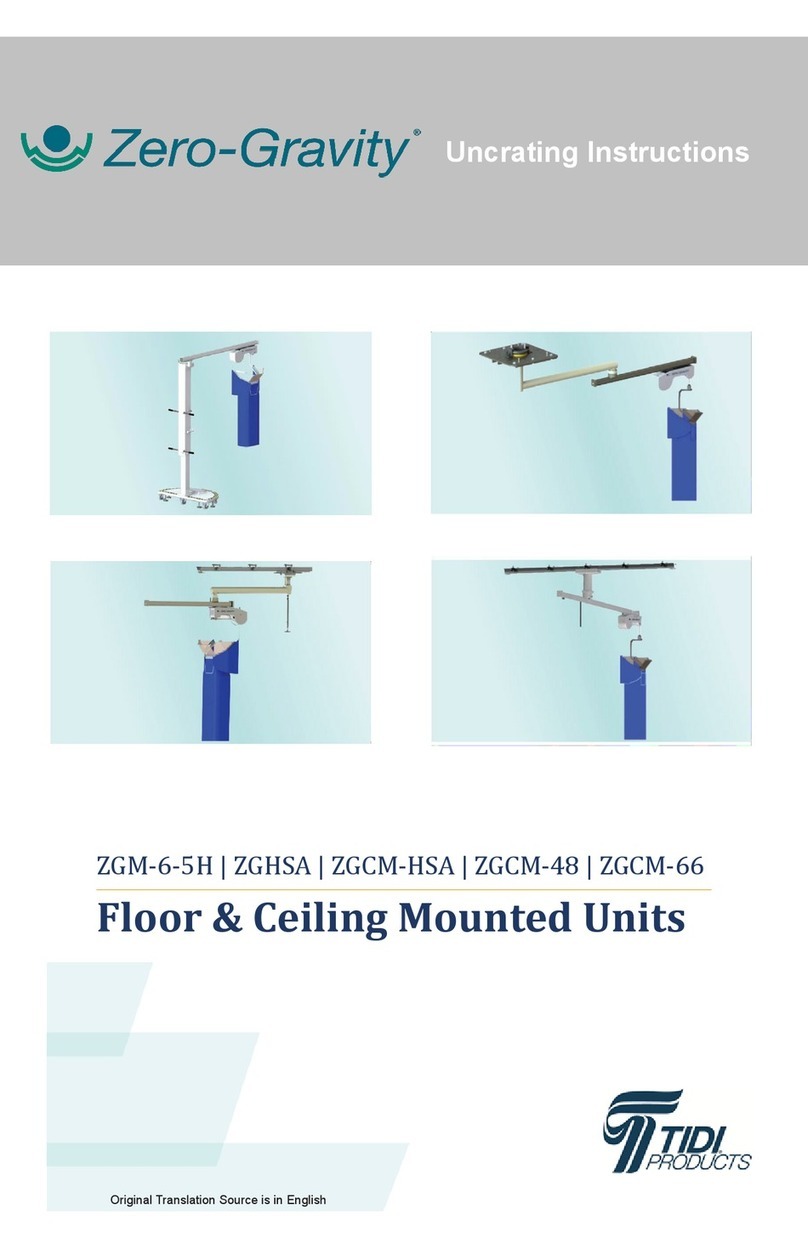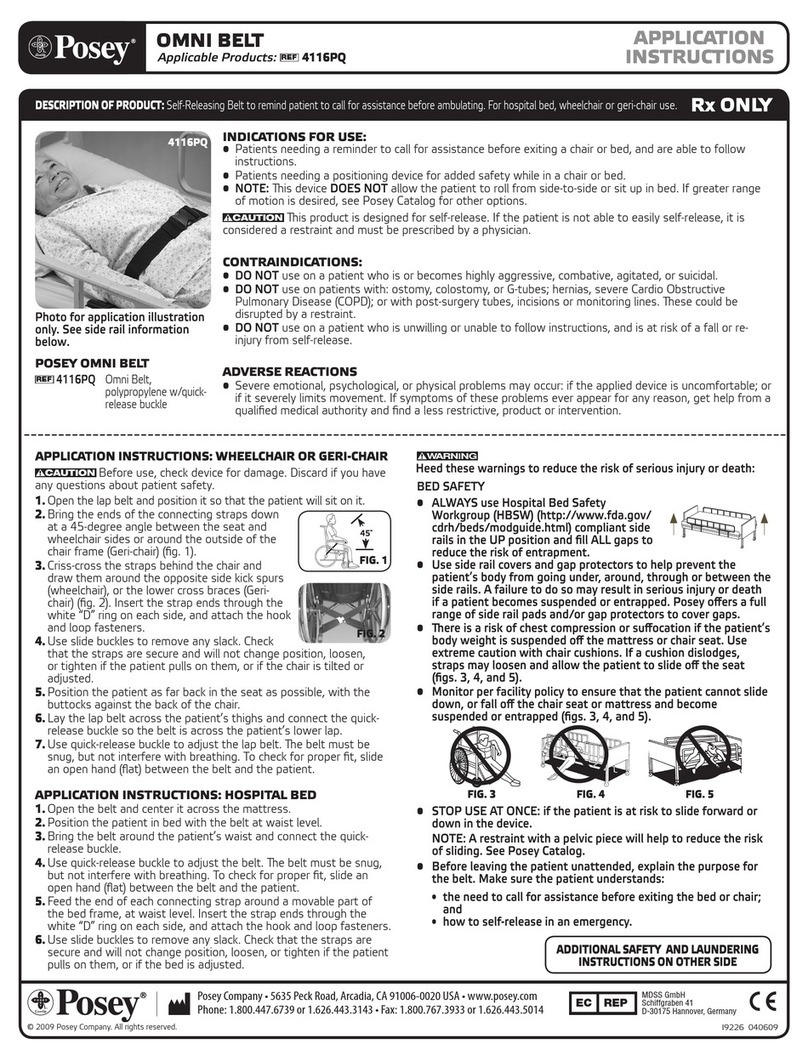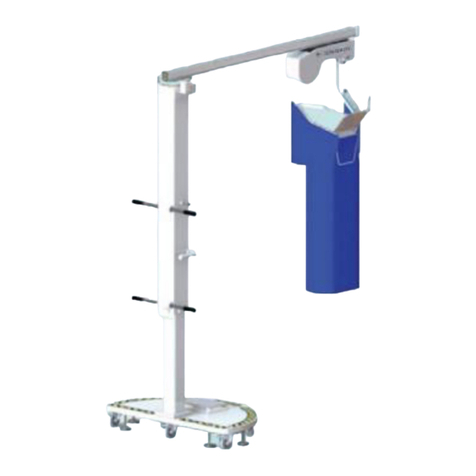TIDI Posey Sitter On Cue User manual

Sitter On CueTM
Instruction Manual
Before using the Posey Sitter On Cue, read this entire manual and save for future reference.
The Posey Sitter On Cue Alarm
is an important part of your falls
management program.
Ensure all parts of this system
are operational before leaving
a patient unattended.
8645
Sitter On Cue®
Instruction Manual
44U00092-D

Sitter On Cue
2
Contents
Before You Begin ......................................................................................................................... 3
Features of the Sitter On Cue ....................................................................................................4-5
Contents and Bracket Options ...................................................................................................... 6
Preparing the Sitter On Cue for Use...........................................................................................7-8
Setting Alarm Mode ................................................................................................................9-10
Setting Alarm Tone..................................................................................................................... 11
Adjusting Alarm Volume ............................................................................................................. 12
Time Delay................................................................................................................................. 13
To Record a Message ................................................................................................................ 14
The HOLD Button .................................................................................................................15-16
Connecting to AC Power (Optional)............................................................................................. 17
Nurse Call Interface...............................................................................................................18-19
Latching Mode ........................................................................................................................... 20
Monitoring with a Sensor.......................................................................................................21-22
Monitoring with Two Sensors...................................................................................................... 23
The Sitter On Cue and Use of Physical Restraints ....................................................................... 24
Warnings and Cautions .........................................................................................................25-26
Mounting the Sitter On Cue...................................................................................................27-29
Alarm Cleaning, Storage and Battery Maintenance ..................................................................... 30
Troubleshooting Guide...........................................................................................................31-33
Alarm Specifications and Warranty............................................................................................. 34
Useful Life.................................................................................................................................. 35
44U00092-D

Sitter On Cue 3
Before You Begin
Important: This system does not prevent falls or injury from falls and is not a substitute for
patient care, rounding and a comprehensive falls management protocol in your facility.
Description: Posey Sitter On Cue Fall Monitor for use with wired sensors and nurse call cable.
Intended use: Alerts staff of attempted bed, chair, stretcher, commode, or toilet seat exits by
patients at risk for falls.
Indications for Use:
Patients who may benefit from the use of the Posey Sitter On Cue include:
• Patients (new or existing) with a history of falls, or who are assessed to be at risk of falling based
on your selected fall-risk assessment
• Patients with diminished cognitive or mobility skills
• Patients receiving medications that may cause disorientation, drowsiness, dizziness, or frequent
urination
• Patients who are restless or prone to get up in the middle of the night, e.g., due to incontinence,
or with nighttime voiding habits
Contraindications:
NOTE: The Sitter On Cue may not be suitable for all high fall-risk patients.
The Sitter On Cue should NEVER be used as the only means of surveillance for:
• Agitated, combative or suicidal patients
•Patients at extreme risk of a life-threatening fall
Response Policy:
Make sure your facility has a clearly defined falls management policy
• Check alarm function every time before leaving patient unattended.
If the alarm and/or sensor do not function properly, remove the alarm and sensor from service and
replace them with a properly functioning alarm and/or sensor. DO NOT use the alarm or sensor if it
does not activate each time weight is removed from the sensor or the alarm belt is unfastened.
BEFORE YOU BEGIN
44U00092-D

Sitter On Cue
4
Features of the Sitter On Cue
REAR VIEW
(OPEN BATTERY DOOR)
FE ATU RES
44U00092-D

Sitter On Cue 5
Features of the Sitter On Cue (Cont.)
•Seven alarm tones. There are seven alarm tone options which can be used in different
patient rooms, or to discern between different caregivers or levels of fall risk for easy patient
identification.
• Four alarm modes. Four alarm modes allow for facility choice regarding caregiver notification
in the event the alarm is triggered. The alarm modes are “Voice and Tone”, “Tone Only”, “Voice
Only” and “Mute.”
•Three alarm volumes. Three alarm volume settings allow for facility choice regarding
caregiver notification in the event the alarm is triggered. The volume options are low, medium
and high. The default alarm tone volume is high. Note: The audible cue volume will always
remain on the lowest setting to promote patient rest but keep the caregiver informed. Audible
cues include confirmation of connections and activation..
• Custom Recording. Allows a family member, friend or caregiver to record a personal message
that will sound if pressure is removed from the sensor pad or alarm belt is unfastened. The
recording will play only if the alarm mode is set to “Voice” or “Voice and Tone”. This feature can
provide patient communication in their language, or by a caregiver or family member for familiarity.
• HOLD Button. Allows the user to pause all monitoring in order to move the patient or adjust the
sensors.
• Optional alarm delay of 0, 1, or 2 seconds. Allows you to adjust alarm timing for each patient.
The delay allows you to define the number of seconds between the time pressure is removed from
the sensor, alarm belt is unfastened, and the time the alarm activates.
• Dual Sensor monitoring. This alarm connects to any Posey sensor pad, (chair, toilet, commode,
stretcher, over-mattress and sensor belt). Alarm activates when weight is removed from sensor
pad, or sensor belt is unfastened. While two sensors can be connected to the alarm, only one can
be used for monitoring at a time.
• Nurse Call Interface. Provides alarm notice at patient’s room and nurse call system notification
points. If connected to nurse call, the Sitter On Cue has the ability to be muted, silencing the
alarm at the patient’s bedside. It will still alarm at nurse call system notification points.
• Latching Mode. When selected, a caregiver is required to interact with the alarm after pressure
is removed from the sensor, even if pressure is re-applied to the sensor pad or the sensor belt is
reattached.
• Failsafe sensor alarm. The Posey Sitter On Cue activates if the alarm is monitoring and a sensor
cord is removed from the alarm.
• Battery operated. The alarm utilizes four (4) “AA” alkaline batteries.
• Visual and Audible low battery warning. Low battery LED will flash red when batteries are
low and an audible cue will say “low battery” when batteries are critically low, alerting caregivers
of the need to change batteries.
• AC Power Adapter Input: For connection of optional external AC power supply (8383AC).
• Impact resistant cover. Helps minimize damage if dropped.
NEVER connect other manufacturers’ sensors to a Posey alarm. Use of
another manufacturer’s sensors may damage the Posey alarm, cause the fall monitoring
system not to function as intended, and will void the factory warranty.
FE ATU RES
44U00092-D
This manual suits for next models
1
Table of contents
Other TIDI Medical Equipment manuals
Popular Medical Equipment manuals by other brands

Getinge
Getinge Arjohuntleigh Nimbus 3 Professional Instructions for use

Mettler Electronics
Mettler Electronics Sonicator 730 Maintenance manual

Pressalit Care
Pressalit Care R1100 Mounting instruction

Denas MS
Denas MS DENAS-T operating manual

bort medical
bort medical ActiveColor quick guide

AccuVein
AccuVein AV400 user manual















